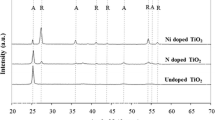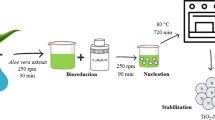Abstract
The bactericidal activity of TiO2 nanoparticles under visible light is very important in regards to its practical applications. In this paper, we synthesized vanadium-pentoxide-loaded TiO2 nanoparticles (V2O5–TiO2) using a chemical vapor condensation method, followed by the impregnation method, and characterized its physicochemical properties through X-ray diffraction patterning, X-ray photoelectron spectroscopy analysis, Raman spectra analysis, and Fourier transform infrared analysis. In addition, the antibacterial activity of V2O5–TiO2 nanoparticles against E. coli was evaluated and compared with pure TiO2 nanoparticles. In these experiments, the population of E. coli was shown to be significantly reduced by V2O5–TiO2 nanoparticles under illumination with fluorescent light, whereas pure TiO2 nanoparticles showed about 3.3-fold lower antibacterial activity than the V2O5–TiO2 nanoparticles. This result was most likely due to the change in surface conditions of the TiO2 nanoparticles, which was due to the loading of vanadium pentoxide on the TiO2 nanoparticles. Furthermore, both photocatalysts showed similar antibacterial activity under UV-A (352 nm) irradiation.







Similar content being viewed by others
References
McDonnell, G., & Russell, A. D. (1999). Antiseptics and disinfectants: activity, action, and resistance. Clinical Microbiology Reviews, 12, 147–179.
Kim, T. N., Feng, Q. L., Kim, J. O., Wu, J., Wang, H., Chen, G. C., & Cui, F. Z. (1998). Antimicrobial effects of metal ions (Ag+, Cu2+, Zn2+) in hydroxyapatite. Journal Materials Science: Materials Medicine, 9, 129–134.
Maness, P., Smolinski, S., Blake, D. M., Huang, Z., Wolfrum, E. J., & Jacoby, W. A. (1999). Bactericidal activity of photocatalytic TiO2 reaction: toward an understanding of its killing mechanism. Applied Environmental Microbial, 65, 4094–4098.
Kikuchi, Y., Sunada, K., Iyoda, T., Hashimoto, K., & Fujishima, A. (1997). Photocatalytic bactericidal effect of TiO2 thin films: dynamic view of the active oxygen species responsible for the effect. Journal Photochemistry Photobiology A: Chemistry, 106, 51–56.
Huang, Z., Maness, P. C., Blake, D. M., Wolfrum, E. J., Smolinski, S. L., & Jacoby, W. A. (1999). Bactericidal mode of titanium dioxide photocatalysis. Journal Photochemistry Photobiology A: Chemistry, 130, 163–170.
Wei, C., Lin, W., Zainal, N. E., Williams, K., Zhu, A. P., Kruzic, R. L., Smith, K., & Rajeshwar, K. (1994). Bactericidal activity of TiO2 photocatalyst in aqueous media: Toward a solar assisted water disinfection system. Environmental Science and Technology, 28, 934–938.
Rincón, G., & Pulgarin, C. (2003). Photocatalytical inactivation of E. coli: effect of (continuous–intermittent) light intensity and of (suspended-fixed) TiO2 concentration. Applied Catalysis B: Environmental, 44, 263–284.
Dunlop, P. S. M., Byrne, J. A., Manga, N., & Eggins, B. R. (2002). The photocatalytic removal of bacterial pollutants from drinking water. Journal Photochemistry Photobiology A: Chemistry, 148, 355–363.
Huang, N., Xiao, Z., Huang, D., & Yuan, C. (1998). Photochemical disinfection of Escherichia coli with a TiO2 colloid solution and a self-assembled TiO2 thin film. Supramolecular Science, 5, 559–564.
Anpo, M., & Takeuchi, M. (2003). The design and development of highly reactive titanium oxide photocatalysts operating under visible light irradiation. Journal of Catalysis, 216, 505–516.
Caballero, L., Whitehead, K. A., Allen, N. S., & Verran, J. (2009). Inactivation of Escherichia coli on immobilized TiO2 using fluorescent light. Journal Photochemistry Photobiology A: Chemistry, 202, 92–98.
Ashkarran, A. A. (2011). Antibacterial properties of silver-doped TiO2 nanoparticles under solar simulated light. Journal Theory Applied Physics, 4–4, 1–8.
Shieh, K., Li, M., Lee, Y., Sheu, S., Liu, Y., & Wang, Y. (2006). Antibacterial performance of photocatalyst thin film fabricated by defection effect in visible light. Nanomedicine, 2, 121–126.
Wang, D., Duan, Y., Luo, Q., Li, X., An, J., Bao, L., & Shi, L. (2012). Novel preparation method for a new visible light photocatalyst: mesoporous TiO2 supported Ag/AgBr. Journal of Materials Chemistry, 22, 4847–4854.
Wong, M., Chu, W., Sun, D., Huang, H., Chen, J., Tsai, P., Lin, N., Yu, M., Hsu, S., Wang, S., & Chang, H. (2006). Visible-light-induced bactericidal activity of a nitrogen-doped titanium photocatalyst against human pathogens. Applied Environmental Microbiology, 72, 6111–6116.
Paul, T., Miller, P., & Strathmann, T. (2007). Visible-light-mediated TiO2 photocatalysis of fluoroquinolone antibacterial agents. Environmental Science and Technology, 41, 4720–4727.
Akhavan, O. (2009). Lasting antibacterial activities of Ag–TiO2/Ag/a-TiO2 nanocomposite thin film photocatalysts under solar light irradiation. Journal Colloid Interface Science, 336, 117–124.
Akhavan, O., Azimirad, R., Safa, S., & Larijani, M. (2010). Visible light photo-induced antibacterial activity of CNT-doped TiO2 thin films with various CNT contents. Journal of Materials Chemistry, 20, 7386–7392.
Akhavan, O., Abdolahad, M., Abdi, Y., & Mohajerzadeh, S. (2009). Synthesis of titania/carbon nanotube heterojunction arrays for photoinactivation of E. coli in visible light irradiation. Carbon, 47, 3280–3287.
Chin, S., Park, E., Kim, M., & Jurng, J. (2010). Photocatalytic degradation of methylene blue with TiO2 nanoparticles prepared by a thermal decomposition process. Powder Technology, 201, 171–176.
Spurr, R. A., & Myers, H. (1957). Spectrophotometric determination of copper in titanium. Analytical Chemistry, 29, 750–754.
Akurati, K. K., Vital, A., Fortunato, G., Hany, R., Nueesch, F., & Graule, T. (2007). Flame synthesis of TiO2 nanoparticles with high photocatalytic activity. Solid State Sciences, 9, 247–257.
Djerad, S., Tifouti, L., Crocoll, M., & Weisweiler, M. (2004). Effect of vanadia and tungsten loadings on the physical and chemical characteristics of V2O5–WO3/TiO2 catalysts. Journal Molecular Catalysis A: Chemistry, 208, 257–265.
Ohsaka, T., Izumi, F., & Fujiki, Y. (1978). Raman spectrum of anatase, TiO2. Journal of Raman Specroscopy, 7, 321–324.
Hyun, C. C., Young, M. J., & Seung, B. K. (2005). Size effects in the Raman spectra of TiO2 nanoparticles. Vibrational Spectroscopy, 37, 33–38.
Kuo, C., Tseng, Y., Huang, C., & Li, Y. (2007). Carbon-containing nano-titania prepared by chemical vapor deposition and its visible-light-responsive photocatalytic activity. Journal Molecular Catalysis A: Chemistry, 270, 93–100.
Jing, L. Q., Fu, H. G., Wang, B. Q., Wang, D. J., Xin, B. F., Li, S. D., & Sun, J. Z. (2006). Effects of Sn dopant on the photo induced charge property and photocatalytic activity of TiO2 nanoparticles. Applied Catalysis B: Environmental, 62, 282–291.
Ding, Z., Lu, G. Q., & Greenfield, P. F. (2000). Role of the crystallite phase of TiO2 in heterogeneous photocatalysis for phenol oxidation in water. The Journal of Physical Chemistry. B, 104, 4815–4820.
Sigaev, V. N., Pernice, P., Aronne, A., Akimova, O. V., Stefanovich, S. Y., & Scaglione, A. (1990). Surface studies of TiO2–SiO2 glasses by X-ray photoelectron spectroscopy. Journal of Non-Crystalline Solids, 126, 202–208.
Qin, X., Jing, L., Tian, G., Qu, Y., & Feng, Y. (2009). Enhanced photocatalytic activity for degrading Rhodamine B solution of commercial Degussa P25 TiO2 and its mechanisms. Journal of Hazardous Materials, 172, 1168–1174.
Chin, S., Park, E., Kim, M., Bae, G., & Jurng, J. (2012). Synthesis and visible light photocatalytic activity of transition metal oxide (V2O5) loading on TiO2 via a chemical vapor condensation method. Materials Letters, 75, 57–60.
Kim, Y. S., Linh, L. T., Park, E., Chin, S., Bae, G., & Jurng, J. (2012). Antibacterial performance of TiO2 ultrafine nanopowder synthesized by a chemical vapor condensation method: effect of synthesis temperature and precursor vapor concentration. Powder Technology, 215–216, 195–199.
Acknowledgments
This work has been supported by the Ministry of Environment (192-091-001) and the Ministry of Education, Science and Technology (2011K000750).
Author information
Authors and Affiliations
Corresponding author
Rights and permissions
About this article
Cite this article
Kim, Y.S., Song, M.Y., Park, E.S. et al. Visible-Light-Induced Bactericidal Activity of Vanadium-Pentoxide (V2O5)-Loaded TiO2 Nanoparticles. Appl Biochem Biotechnol 168, 1143–1152 (2012). https://doi.org/10.1007/s12010-012-9847-9
Received:
Accepted:
Published:
Issue Date:
DOI: https://doi.org/10.1007/s12010-012-9847-9




